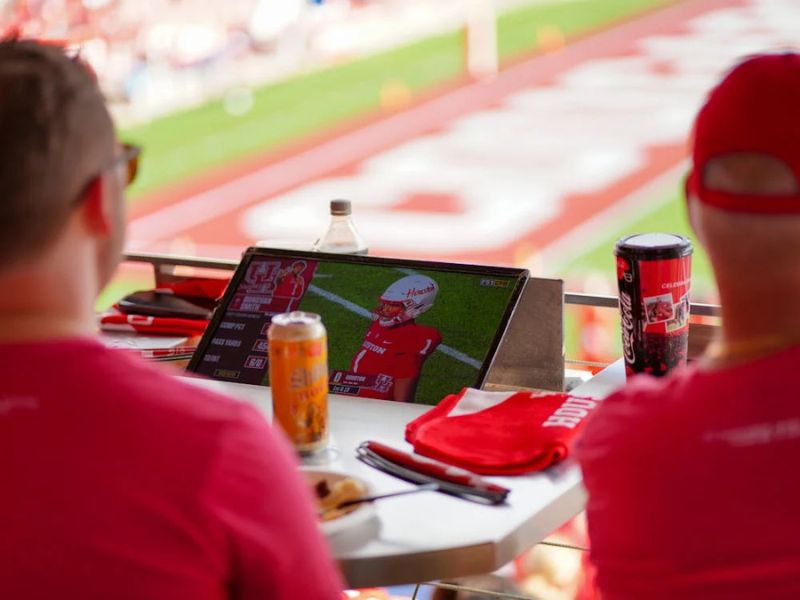The intersection of sports and technology is reshaping how we engage with traditional sports. Adapting to the digital age is crucial for enhancing fan experiences and athlete performance. This article explores key technological advancements driving this transformation.
Key Takeaways
- 5G technology revolutionizes live sports streaming with seamless broadcasts and real-time engagement.
- Artificial Intelligence (AI) enhances athlete performance through precision movement and injury prediction.
- Wearable technology offers personalized training and boosts fan engagement.
- Virtual Reality (VR) and Augmented Reality (AR) provide immersive training and fan experiences.
- The Internet of Things (IoT) connects the sports ecosystem, optimizing performance and venue management.
How Traditional Sports Are Embracing the Digital Age
The digital transformation in sports is more than just a trend; it’s a necessity. Technologies like 5G, AI, VR, AR, and IoT are redefining the sports landscape, enhancing both fan experiences and athlete performance. These innovations are opening new dimensions in the sports industry.
5G Technology: Revolutionizing Live Sports
5G technology is a game-changer for live sports streaming. It eliminates latency, ensuring fans enjoy seamless, buffer-free broadcasts. This high-speed connectivity allows fans to engage in real time, feeling connected to the action as it unfolds.
Transforming Live Sports Streaming
- Latency Reduction: Near-instantaneous data transfer for real-time engagement.
- Buffer-Free Broadcasts: Enhances the immersive viewing experience.
High-Quality Sports Experience
- VR and AR Integration: Coaches and fans access high-definition video feeds, enriching training and viewing experiences.
- Dynamic Fan Engagement: Interactive live commentary and augmented reality experiences during matches.
Artificial Intelligence (AI) in Sports
AI is transforming sports by enhancing performance, preventing injuries, and aiding strategic decisions. It provides precise movement measurement, early injury detection, and data-driven strategies.
Modeling for Precision Movement Measurement
Technique Refinement: Motion capture systems track movements for performance optimization.
Prediction for Injury Prevention
Early Detection: AI models analyze movements to prevent injuries, safeguarding athlete well-being.
Formulas for Strategic Decision-Making
Data-Driven Strategies: AI generates predictive formulas for game tactics and player lineups.
Wearable Technology: Enhancing Performance and Engagement
Wearable technology is revolutionizing sports by providing real-time insights and fostering social connectivity. It enhances athlete development and fan engagement.
Tailored Training and Performance Metrics for Coaches
Real-Time Insights: Coaches tailor training based on heart rate, distance, and sleep patterns.
Integration with Sports Apps
Centralized Data Hub: Apps like Strava sync data for streamlined tracking and community building.
Social Connectivity and Fan Engagement
Community Building: Fans track athletes’ progress, enhancing the sports experience.
Virtual Reality (VR) and Augmented Reality (AR) in Sports
VR and AR are creating immersive experiences for athletes and fans. They offer realistic training environments and interactive fan experiences.
Enhanced Training and Simulation for Athletes
Realistic Environments: Athletes practice in conditions mimicking real competitions.
Fan Engagement and Virtual Stadium Experience
Immersive Experiences: Fans enjoy the excitement of live games from home, expanding global reach.
Interactive Fan Experiences
Virtual Meet-and-Greets: Fans access behind-the-scenes content, deepening engagement.
How Online Betting Platforms Are Expanding into Casino Experiences
Online betting platforms are expanding by adding online casino experiences to their offerings. These platforms bring sports-themed gaming options, such as sports-inspired slots, virtual games, and interactive events, to fans who want more than just traditional sports betting.
For example, platforms like New Jersey Online Casino provide options that capture the excitement of live sports events through casino-style games. By combining sports and casino entertainment, these platforms create a complete experience, giving fans more ways to engage with sports online.
This blend of sports and gaming not only expands entertainment options but also strengthens fans’ connection to their favorite teams and events.
Internet of Things (IoT): Connecting the Sports Ecosystem
IoT is at the forefront of sports technology, enhancing everything from streaming to recruitment.
Streaming Apps and IoT Integration
Interactive Features: Fans engage in real-time, transforming passive watching into active participation.
Smart Clothing for Athletes
Optimized Health Metrics: Smart clothing provides insights for performance enhancement.
Smart Stadiums Optimization
Enhanced Safety and Communication: IoT streamlines operations and resource management.
Revolutionizing Recruitment and Scouting
Data-Driven Talent Identification: Real-time metrics aid in recognizing promising athletes.
Global Expansion and Streaming Initiatives
Traditional sports leagues are leveraging streaming to reach international audiences, expanding their global presence. This initiative allows fans worldwide to engage with their favorite sports.
Conclusion
Technology is reshaping traditional sports, enhancing experiences for fans and athletes alike. The future of sports in the digital age promises exciting advancements. Embracing these technologies is essential for continued growth and engagement in the sports industry.






